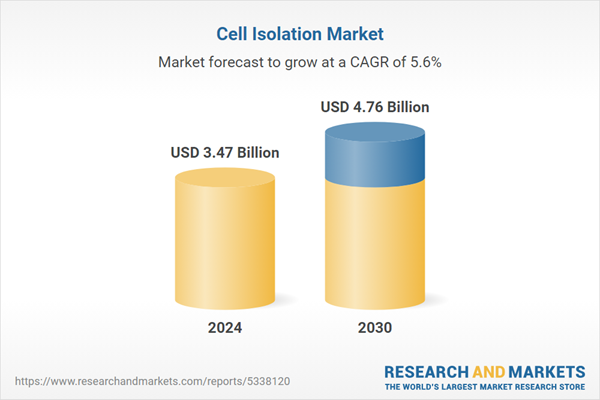Speak directly to the analyst to clarify any post sales queries you may have.
10% Free customizationThis report comes with 10% free customization, enabling you to add data that meets your specific business needs.
A primary growth driver is the growing adoption of personalized medicine, which depends on isolating patient-specific cells for the development of targeted therapies. This need is particularly prominent in oncology, where immunotherapies and cell-based treatments require accurate cell selection. While high costs and technical barriers pose challenges - especially in isolating rare or delicate cell types - emerging markets in the Asia-Pacific region are creating new opportunities for expansion, supported by growing investments in healthcare infrastructure, research capabilities, and pharmaceutical manufacturing.
Key Market Drivers
Growth in Healthcare Industry
The expansion of the global healthcare industry is a central factor driving the growth of the cell isolation market. With annual revenues exceeding USD 4 trillion, healthcare is supported by key sectors such as pharmaceuticals and biotechnology, contributing nearly USD 850 billion, and medical technology and diagnostics, which account for over USD 400 billion. This industry growth - especially in emerging economies - is accelerating the adoption of advanced diagnostic and therapeutic tools, including cell-based solutions.As hospitals, laboratories, and pharmaceutical firms increasingly invest in regenerative therapies and precision medicine, the demand for scalable and reliable cell isolation techniques is rising. Additionally, the increasing global prevalence of chronic illnesses, including cancer and autoimmune diseases, has intensified the need for targeted therapies. In 2021, noncommunicable diseases were responsible for over 43 million deaths globally, with the majority occurring prematurely in low- and middle-income countries - reinforcing the importance of cell-based technologies for future treatment protocols.
Key Market Challenges
High Cost of Cell Isolation Technologies
The high cost associated with cell isolation technologies continues to be a major limitation for broader adoption, particularly in resource-limited settings. Systems like fluorescence-activated cell sorting (FACS) and magnetic-activated cell sorting (MACS) require sophisticated instruments, proprietary reagents, and specialized personnel, all contributing to significant operational costs.These expenses present a substantial barrier for smaller laboratories, academic institutions, and biotech startups. Moreover, ongoing costs - such as maintenance, consumables, and technical support - can hinder the full utilization of cell isolation tools, especially in developing countries where funding and access to infrastructure are limited.
Key Market Trends
Increased Demand for Cell-Based Therapies
A key trend influencing the cell isolation market is the rising demand for cell-based therapies. By 2035, treatments such as CAR-T, TCR, and TIL therapies are expected to make up over 45% of clinical demand for cell therapy products. These therapies are gaining traction for their ability to address a wide array of diseases, including cancer, autoimmune conditions, and degenerative disorders.This shift toward cell-based interventions is driving the need for robust isolation technologies that can reliably deliver high-quality, contamination-free, and functional cells. As the industry focuses more on precision medicine, the development and clinical use of cell therapies require advanced systems capable of delivering consistent and reproducible results in complex workflows.
Key Market Players
- Becton, Dickinson & Company
- Merck KGaA
- Thermo Fisher Scientific Inc.
- Bio-Rad Laboratories Inc.
- Terumo Corporation
- PluriSelect Life Science UG & Co. KG
- Danaher Corporation
- STEMCELL Technologies Inc.
- Corning Inc.
- Akadeum Life Sciences Inc.
Report Scope
In this report, the Global Cell Isolation Market has been segmented into the following categories, in addition to the industry trends which have also been detailed below:Cell Isolation Market, By Cell Type:
- Human Cells
- Animal Cells
Cell Isolation Market, By Application:
- Biomolecule Isolation
- Cancer Research
- Stem Cell Research
- In Vitro Diagnostics
- Others
Cell Isolation Market, By Region:
- North America
- United States
- Canada
- Mexico
- Europe
- France
- United Kingdom
- Italy
- Germany
- Spain
- Asia Pacific
- China
- India
- Japan
- Australia
- South Korea
- South America
- Brazil
- Argentina
- Colombia
- Middle East & Africa
- South Africa
- Saudi Arabia
- UAE
Competitive Landscape
Company Profiles: Detailed analysis of the major companies present in the Global Cell Isolation Market.Available Customizations
With the given market data, the publisher offers customizations according to a company's specific needs. The following customization options are available for the report.Company Information
- Detailed analysis and profiling of additional market players (up to five).
This product will be delivered within 1-3 business days.
Table of Contents
Companies Mentioned
- Becton, Dickinson & Company
- Merck KGaA
- Thermo Fisher Scientific Inc.
- Bio-Rad Laboratories Inc.
- Terumo Corporation
- PluriSelect Life Science UG & Co. KG
- Danaher Corporation
- STEMCELL Technologies Inc.
- Corning Inc.
- Akadeum Life Sciences Inc.
Table Information
| Report Attribute | Details |
|---|---|
| No. of Pages | 185 |
| Published | June 2025 |
| Forecast Period | 2024 - 2030 |
| Estimated Market Value ( USD | $ 3.47 Billion |
| Forecasted Market Value ( USD | $ 4.76 Billion |
| Compound Annual Growth Rate | 5.6% |
| Regions Covered | Global |
| No. of Companies Mentioned | 10 |









